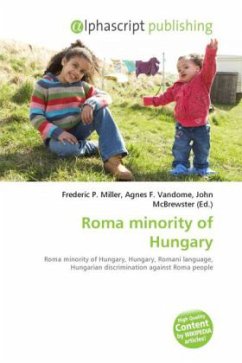
Roma in Hungary
Versandkostenfrei!
Versandfertig in 6-10 Tagen
30,99 €
inkl. MwSt.

PAYBACK Punkte
15 °P sammeln!
Please note that the content of this book primarily consists of articles available from Wikipedia or other free sources online.The Roma (Hungarian: cigányok or romák) in Hungary represents ~2% (2001 census) or 6-11% (unofficial estimation) of the total population. Since World War II, the number of Roma has increased rapidly, multiplying sevenfold in the last century. Today every fifth or sixth newborn is Rom. Estimates based on current demographic trends project that in 2050, 20.9% of the population (2.9 million people) will be Roma. The Roma continue to be among the poorest in the country. ...
Please note that the content of this book primarily consists of articles available from Wikipedia or other free sources online.The Roma (Hungarian: cigányok or romák) in Hungary represents ~2% (2001 census) or 6-11% (unofficial estimation) of the total population. Since World War II, the number of Roma has increased rapidly, multiplying sevenfold in the last century. Today every fifth or sixth newborn is Rom. Estimates based on current demographic trends project that in 2050, 20.9% of the population (2.9 million people) will be Roma. The Roma continue to be among the poorest in the country. Their birth rates are much higher and their average expected life span is significantly lower than the national average. Roma continue to be discriminated and live a harsh life in Hungary. They often face hardship and prejudice, and many live in poverty.












